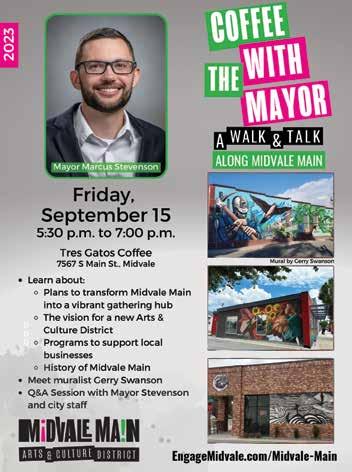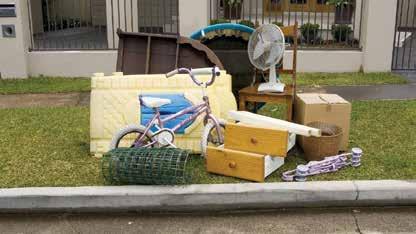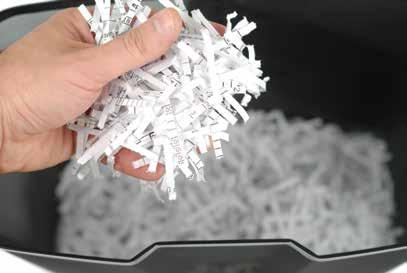MIDVALE CITY DIRECTORY

City Hall


City Hall
801-567-7200
Finance/Utilities 801-567-7200
Court 801-567-7265
City Attorney’s O ce 801-567-7250
City Recorder/Human Resources 801-567-7228
Community Development 801-567-7211
Public Works 801-567-7235
Ace Disposal/Recycling 801-363-9995
Midvale Historical Museum 801-567-7285
Midvale Senior Center 385-468-3350
SL County Animal Services 385-468-7387
Communications 801-567-7230


MAYOR
Marcus Stevenson 801-567-7204
Email: mstevenson@midvale.com
CITY COUNCIL
District 1 - Quinn Sperry
Email: qsperry@midvale.com
District 2 - Paul Glover
Email: pglover@midvale.com
District 3 - Heidi Robinson
Email: Hrobinson@midvale.com
District 4 - Bryant Brown
Email: bbrown@midvale.com
District 5 - Dustin Gettel
Email: dgettel@midvale.com
Water Bills 801-567-7200
Ordering A New Trash Can 801-567-7202
Permits 801-567-7213
Court 801-567-7265
Paying For Tra c School 801-567-7202
Business Licensing 801-567-7214 Cemetery 801-567-7235
Planning and Zoning 801-567-7231
Code Enforcement 801-567-7208
Building inspections 801-567-7213
Graffiti 385-468-9769
PUBLIC SAFETY & EMERGENCY CONTACTS
EMERGENCY 911
UFA Fire/UPD Police
> Non-emergency 801-840-4000
Uni ed Police Department
> Midvale Precinct 385-468-9350






Public Works 801-567-7235
Rocky Mountain Power 877-508-5088
By Mayor Marcus Stevenson
When Midvale City was established in 1909, Main Street was its heart. With the smelter to its west, Main Street became the home to smelter o ces, banks, restaurants, and shopping, with the homes in the Avenues neighborhood built for the industrial workers.
Once I-15 was constructed, Main Street was no longer a viable north-south route. The freeway drew tra c away from Main Street and cut o access from the rest of the city that had since expanded to the east. Main Street businesses, therefore, saw a decline in both foot and vehicular tra c. Since then, Main Street has struggled to stay vibrant and support its many local businesses.
Main Street can be described as a “chicken and egg” situation. What comes rst, public investments into the street or private investments into the buildings? Because most of the buildings along Main Street are privately owned, Midvale City cannot force a property owner to invest in a building or bring in a speci c tenant. For years, the private property owners have asked Midvale City to invest in the public side of the street: art, parking, lighting, etc. so they can bring in tenants and be successful. At the same time, Midvale City has asked property owners to invest in revitalizing their buildings and bring in tenants, so the City would have more tax dollars to invest in the public side of the street. In short, we’ve waited for building owners to make the street successful, and they’ve waited for Midvale City to do the same.
Fortunately, at the beginning of 2022, Salt Lake County and Canyons School District voted, and approved, to help fund the Redevelopment Agency (RDA) of Midvale City’s Main Street project area. An RDA allows cities to encourage development in areas where the market has struggled to naturally do so. To help spark development, a project area shifts newly generated property taxes from their usual uses into the project area. As an example, on your property taxes, you pay amounts each year to the school district, county, city, public safety, etc., but if you own property in the Main Street project area, then a portion of your property tax is re-routed and reinvested directly back into the project area. That property tax is then used to encourage development, revitalization, and support a ordable housing initiatives. Turning Main Street into a project area gives our city the resources to start investing in the street in a signi cant way.
Midvale’s goal is to turn Main Street into an arts & culture district, while keeping the same historic feel, investing in current and future businesses, and creating a space where all income levels can own a business and live in the area.
In 2020, the Midvale City Council approved what’s called Form Based Code, which focused on street design, building types, open space, landscaping, and parking. Speci cally, along the street this code ensures that new development brings in a similar style to the older buildings on the street: up against the street, store fronts on the street level, and apartments above. This code is the guide for how Main Street will progress and is the foundation for our many revitalization e orts.
Now that this area is an RDA, the City has been investing heavily in the public side of the street to make Midvale Main a place where residents, businesses, and visitors can enjoy. These improvements are designed to bring a strong sense of place to the street and encourage private investment in new local shops and restaurants.
Here are just some of the ways Midvale City is investing in the public side of Midvale Main:
• Public Art – Midvale has invested in murals with Los Muros on Main: Midvale City Mural Festival. We now have 33 murals along the street, which helps improve the feel and safety of the street.
• Community events – Along with the mural festival, Midvale hosts Trick or Treat on Main Street for Halloween, and Light Up Main Street for the winter holidays. Additionally, we’ve partnered with private groups for both the Main Street Car Show and the Tattoo Showdown. We are always looking for new opportunities to bring visitors to our street.
• City Hall Plaza – an important piece of the Main Street puzzle, is ensuring that both ends of the street are activated. This is part of the reason why we are building a plaza on the north side of City Hall, which will act as a year-round community space, and host the Utah Food Truck League throughout the summers. The plaza is expected to be completed early next year.
MAYOR’S MESSAGE CONTINUED ON NEXT PAGE
• Street lighting – it’s critical that the street feels safe and unique, which is why we are investing in better lighting. We will be installing festival-type lighting, which can be used on a day-to-day basis, and for the events we hold. String lighting that drapes across the street is one example of lighting we are looking at, which is expected to be installed early next year.
• Street & sidewalk design – to help slow down cars, we’ve recently added bulb outs onto the street. This is where you expand the sidewalk further into the street, and then you can activate this space, usually with outdoor dining. This not only better engages the street but helps slow down drivers on the road. You can see a bulb out example in front of Tres Gatos Co ee.
• Parking – While we have a focus of tying the surrounding neighborhoods directly into Main Street, we also recognize that we need to ensure adequate parking. Midvale has longterm plans for three above-ground parking structures adjoining the street, to support future businesses, residents, and visitors. The process of designing these parking structures is expected to start next year.
Midvale is also incentivizing private property owners to invest in their buildings. Here’s how:
• Façade Improvement Program – earlier this year, Midvale City approved a new grant program to help property owners improve their storefront, signage, and landscaping. As an example, restoring the Vincent Drug sign would not be an easy or cheap thing to do, but this program gives the private building owner an option to apply for funds to restore the historic signage, which will help transform the way Main Street looks and feels.
• Small Business Loan Program – this program gives low-interest loans to businesses to help remodel their buildings. The Pearl, a theater on Main Street, was approved a loan that they’ve been using to invest in remodeling their building. This program helps ensure that the existing businesses can keep up with the progress being made on the street and that the City can attract the right businesses to activate the street.
• Upper Floor Housing Initiative – this program is focused on ensuring the housing along the street remains a ordable. These funds are used to keep current and future units a ordable by incentivizing property owners to provide units at below market rate. As the street progresses, this program will help keep a ordability in place for both current and future residents.
While Midvale Main still has many more years of revitalization to go, things are moving in the right direction. I hope our residents will remain excited, while also patient, as we work to revitalize this area in a way that honors its history and supports the diverse businesses that have called Main Street home for many years.
MIDVALE MAIN WALK & TALK

SEPTEMBER 15 AT 5:30 P.M.
If you’d like to learn more about our plans for Midvale Main, please join city sta and I for a Midvale Main Walk & Talk, in conjunction with Co ee (or whatever you drink) with the Mayor on September 15. This will be an opportunity for residents to get an in-depth view of our revitalization e orts and have your questions about our e orts answered. We’ll start at Tres Gatos Co ee at 5:30 and then work our way down the street as we talk about the past, present, and future of our historic Main Street.
Creating a family communication plan is a proactive and important step to ensure that your family is well-prepared and can stay connected during emergencies or unexpected situations. Here’s a step-by-step guide to help you create an e ective family communication plan:
1. Identify Possible Scenarios: Start by listing potential emergencies or situations that might require communication. These could include natural disasters (earthquakes, hurricanes), accidents, medical emergencies, power outages, and more.
2. Contact Information: Create a list of essential contact information for each family member. Keep in mind that your cell phone may or may not work or you may not have it during an emergency. This should include:
• Full names
• Phone numbers (home, work, mobile)
• Email addresses
• Social media pro les
• Addresses (home, work, school)
3. Emergency Contacts: Include contacts for friends, neighbors, and relatives who live outside your immediate area. These individuals can serve as points of contact if local communication is disrupted.
4. Designate Central Contact: Choose an out-oftown family member or friend as the central contact person. This person can act as a hub for information dissemination since local communication might be a ected during emergencies.
5. Communication Methods: Determine the primary and backup methods of communication:
• Phone calls
• Text messages
• Social media
• Video calls
• Messaging apps (WhatsApp, Telegram)

• Two-way radios
6. Meeting Places: Identify safe meeting places both within your neighborhood and outside of it. Choose a spot near your home as well as a location further away in case your immediate area is a ected. A mailbox or the neighbor’s tree across the street are great options.
7. Emergency Services: Teach family members how to access emergency services in your area, including police, re, medical services, and local emergency numbers.
8. Special Needs: Consider any special needs your family members may have. This could include medical conditions, medications, mobility issues, or language barriers. Make provisions to accommodate these needs during emergencies.
9. Practice Drills: Regularly conduct practice drills to ensure that everyone knows the communication plan. This will help your family respond e ectively and quickly during a real emergency.
10. Update Information: Review and update the contact information regularly. As phone numbers change or new family members are added, make sure your plan remains current.
11. Distribute the Plan: Distribute copies of the communication plan to all family members. Keep physical copies in easily accessible locations like wallets, purses, and backpacks, and store digital copies on smartphones, computers, and cloud storage.
12. School and Workplace Plans: Discuss and understand the emergency communication plans at schools and workplaces. This will help you coordinate actions and communication during an emergency that occurs when family members are separated. As often parents are at work and kids are in school when events occur.

13. Regular Check-Ins: Make it a habit to check in with family members, especially during extreme weather conditions or other potentially hazardous situations.
14. Community Resources: Familiarize yourself with local community resources and emergency services that can assist during di erent types of emergencies.
Remember that the goal of a family communication plan is to ensure everyone’s safety and well-being. Regularly reviewing and practicing the plan will help your family stay prepared and connected in times of crisis.



























A simple accident like tripping over a rug or slipping on a wet oor can change your life. According to the National Institute on Aging more than one in four people aged 65 years or older fall each year. The risk of falling – and fall-related problems – rises with age. However, many falls can be prevented. Join us on Wednesday, September 13, from 12:30 p.m. to 2:30 p.m., at Midvale Senior Center for a Fall Prevention Event. Sally Aerts, a fall prevention specialist, will discuss how to stay active and independent and Alicia Nichole Shepard, of the Utah Department of Health and Human Services, will discuss state-level fall prevention e orts. There will be Tai Chi and EnhanceFitness demonstrations, tness checks and a drawing with prizes.
